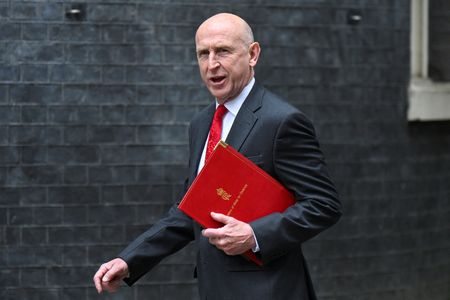By Jamie McGeever
ORLANDO, Florida (Reuters) -TRADING DAY
Making sense of the forces driving global markets
By Jamie McGeever, Markets Columnist
A sense of euphoria washed over global stock markets on Wednesday as a U.S.-Japan trade deal and indications of a U.S.-Europe agreement lifted major indexes around the world, pushing the S&P 500 and MSCI All Country to new highs.
More on that below. In my column today I look at why the U.S. bond market has been so calm lately despite swirling fears over tariffs, deficits and inflation. Foreign demand, especially from the private sector, appears to have returned with a bang.
If you have more time to read, here are a few articles I recommend to help you make sense of what happened in markets today.
1. U.S.-Japan trade deal averts worst for global economy 2. Japan trade deal breaks U.S. tariff template 3. EU to advance retaliation on U.S. goods as tariff hikelooms 4. AI and gravity-defying U.S. GDP: Mike Dolan 5. U.S. stock market concentration risks come to fore asmegacaps report earnings
Today’s Key Market Moves
* S&P 500 and MSCI World hit record highs on investoreuphoria following U.S.-Japan trade deal. * VIX volatility index falls to a 5-month low of 15.32. * Japan’s Nikkei soars 3.5% to a one-year high above 41,000points. Toyota shares leap 14%, biggest rise since 2008. * Eurostoxx futures jump 2% on reports U.S. and EU areclosing in on 15% tariff deal. * The dollar falls for a third day, dragging the dollarindex down towards its recent three and a half-year low.
Tracking trade – from gloom to boom
The tariff pessimism that choked markets immediately following President Donald Trump’s ‘Liberation Day’ in early April seems like an age ago. The U.S.-Japan deal and signs of progress on a U.S.-Europe accord injected buoyant stocks with a further dose of adrenaline on Wednesday.
At first blush, the Japan deal looks to be much better than investors had expected, with the U.S. tariff on Japanese imports set at 15% instead of the previously threatened 25%. This includes autos too, the largest single component of the U.S. trade deficit with Japan.
Investors appear to be cheering the 15% rate. If this is the level agreed upon in the U.S.-EU deal, as European diplomats suggest, it will be half the 30% levy Trump is currently threatening to impose. Relative to the worst-case expectations, that’s also a huge relief for markets.
At least that’s how investors are trading it right now. It remains to be seen what the longer-term tariff impact on growth, inflation, consumer spending, and corporate profits will be.
While the tariff relief dominated markets on Wednesday, equity investors also had the latest wave of U.S. earnings to digest – shares in Google’s parent company Alphabet fell 2% in after-hours trading, and Tesla shares rose around 1%.
In bonds, a $13 billion auction of 20-year Treasuries was met with strong demand, selling at nearly two basis points below the market at the bidding deadline. This helped limit the broad rise in yields underway on the back of the trade optimism.
It was a different story in Japan, where the first sale of 40-year debt since Sunday’s upper house election defeat for Prime Minister Shigeru Ishiba logged the weakest demand in almost 14 years. The 40-year yield climbed towards its recent 17-year high, and the 10-year yield hit its highest since 2008.
Ishiba denied reports that he is about to resign. But uncertainty around his future, fiscal policy and the Bank of Japan’s rate path is extremely high.
Thursday’s focus will turn to the European Central Bank, which is expected to pause after eight consecutive rate cuts and keep its deposit rate on hold at 2.00%.
Foreign demand for U.S. Treasuries holds off bond vigilantes
So much for the bond vigilantes.
The U.S. bond market has been remarkably calm lately, despite fears that inflation, tariffs, eroding Fed independence, and Washington’s ballooning debt load will push up Treasury yields. What explains the resilience?
The above concerns remain valid, of course, as any one of them could eventually cast a long shadow over the world’s largest and most important market.
But that doesn’t seem to be on the immediate horizon. The so-called bond vigilantes – those investors determined to bring profligate governments into line by forcing up their borrowing costs – might have been driving bond prices lower earlier this year, but they are taking a back seat now.
The 10-year Treasury yield on Tuesday closed at 4.34%. That’s below the year-to-date average of 4.40%, and less than 10 basis points above the one- and two-year averages.
Perhaps even more surprising, implied Treasury market volatility is hovering at its lowest levels in three-and-a-half years, further evidence that investors have little fear of an imminent spike in borrowing costs.
OVERSEAS DEMAND
The obvious explanation is that demand for Treasuries has picked up, investors lured back into the market by attractive yields on 10-year bonds approaching 5% and even juicer returns on 30-year paper. Concern about an economic slowdown, and thus lower interest rates, is likely adding fuel to this trend.
A lot of this demand has likely come from overseas, based on the latest release of Treasury International Capital flows data. Admittedly, these figures are released with a lag, but they are among the most reliable and closely tracked of all international flows information.
The TIC data show that the foreign official and private sectors bought a net $146.3 billion of U.S. Treasury notes and bonds in May on a non valuation-adjusted basis. That’s the second-highest monthly total ever. And if you include corporate debt, agency bonds and equities, total foreign purchases of U.S. securities in May were the highest on record.
Private sector investors accounted for roughly 80% of that total. Their holdings of U.S. Treasuries began to outstrip official holdings a few years ago, and that trend seems to be accelerating. They now hold over $5 trillion, compared to the official sector’s $4 trillion.
Bank of America’s U.S. rates strategy team notes that outsized foreign private demand has also been evident in more recent flows data, particularly from Japanese investors who have bought more than $60 billion in overseas bonds since the start of May.
Demand from private sector buyers like pension funds is generally thought to be more price-sensitive than reserve managers and sovereign wealth funds, who are more inclined to buy and hold for the very long term.
REGULATION, STABLECOINS
Will the back end of the yield curve remain resilient?
This will obviously depend in part on what happens in the U.S. economy. But there are a few exogenous factors that could boost demand moving forward, including potential regulatory changes to the U.S. banking system and the accelerated adoption of cryptocurrency stablecoins.
First, the Fed has proposed revisions to the supplementary leverage ratio, which would free up capital for banks to hold more Treasuries. That could generate an estimated $1.1 trillion in extra buying capacity.
Next, the increased use of stablecoins, digital tokens that are pegged 1:1 to highly liquid assets like T-bills, short-dated bonds or the U.S. dollar, could drive demand for shorter-dated Treasuries. The House of Representatives last week passed a bill to create a regulatory framework for stablecoins, and U.S. President Donald Trump is expected to sign it into law soon.
HIBERNATING BEARS
Despite all this, there are still plenty of bond bears out there with good reasons to be bearish, not least the $1 trillion flood of new debt issuance expected before this year is out.
But what the market action in the first half of this year has shown – filled as it has been with heightened uncertainty around tariffs, geopolitics, deficits and the Fed – is that bond market selloffs aren’t likely to last long.
That’s partly because of the lack of a true alternative. The near-$30 trillion Treasury market is bigger than the Chinese, Japanese, French, UK and Italian government bond markets combined. And it is more than ten times bigger than the German Bund market, the euro zone’s premium safe-haven asset.
Underlying demand is stronger than the vigilantes have bargained for.
What could move markets tomorrow?
* South Korea GDP (Q2, advance) * Japan PMIs (July) * Germany GfK consumer sentiment (August) * Euro zone PMIs (July) * UK PMIs (July) * European Central Bank interest rate decision * U.S. weekly jobless claims * U.S. new home sales (June) * U.S. PMIs (July) * U.S. Treasury auctions $21 billion of 10-year TIPS * U.S. Q2 earnings, including Newmont, T-Mobile, Honeywell
Want to receive Trading Day in your inbox every weekday morning? Sign up for my newsletter here.
Opinions expressed are those of the author. They do not reflect the views of Reuters News, which, under the Trust Principles, is committed to integrity, independence, and freedom from bias.
(By Jamie McGeever; Editing by Nia Williams)











